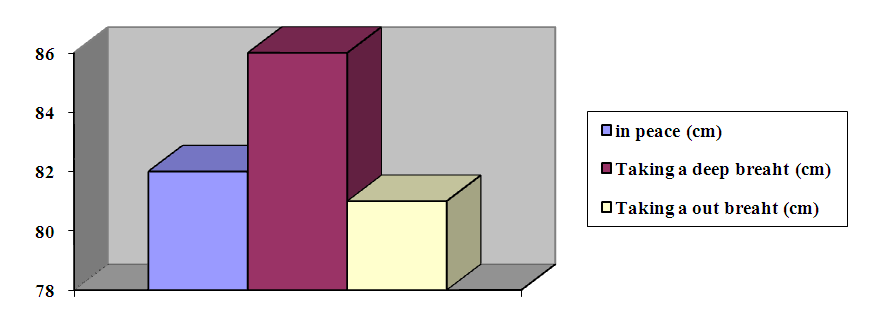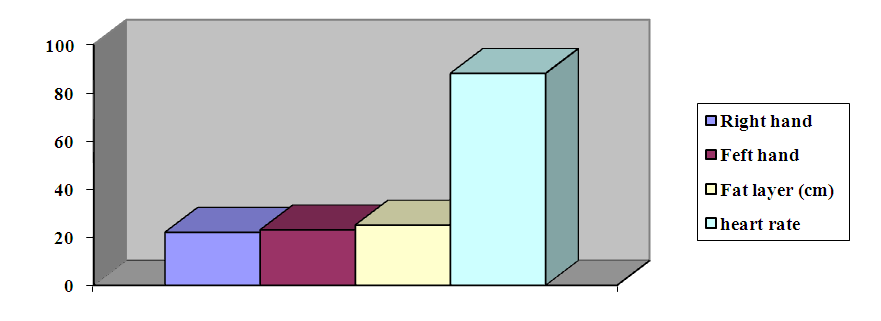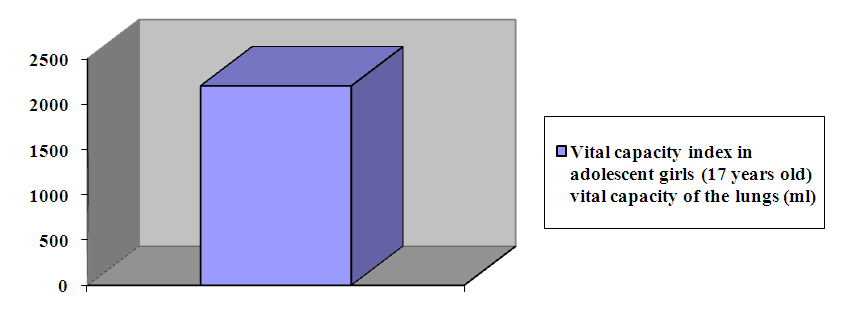-
Paper Information
- Next Paper
- Paper Submission
-
Journal Information
- About This Journal
- Editorial Board
- Current Issue
- Archive
- Author Guidelines
- Contact Us
American Journal of Medicine and Medical Sciences
p-ISSN: 2165-901X e-ISSN: 2165-9036
2024; 14(12): 3295-3297
doi:10.5923/j.ajmms.20241412.46
Received: Nov. 22, 2024; Accepted: Dec. 15, 2024; Published: Dec. 26, 2024

Indicators of Physical Development and Age Characteristics of Adolescent Girls
F. N. Mirzabekova, G. Z. Fahriddinova
Andijan State University, Andijan, Uzbekistan
Copyright © 2024 The Author(s). Published by Scientific & Academic Publishing.
This work is licensed under the Creative Commons Attribution International License (CC BY).
http://creativecommons.org/licenses/by/4.0/

We determined the morphological and physiological indicators of adolescent girls (17-year) in order to determine indicators of physical development. The study of the physical development of the growing young adolescent girl body is of great importance in determining the health of the nation's gene pool. At the same time, the study of age-related characteristics is an important indicator in determining preventive health measures.
Keywords: Anatomical and physiological features, Indicators of physical development, Physiological indicators, Morphological indicators, Vitality capacity of lungs, Dinometry, Rostomer, Statistics, Pulse
Cite this paper: F. N. Mirzabekova, G. Z. Fahriddinova, Indicators of Physical Development and Age Characteristics of Adolescent Girls, American Journal of Medicine and Medical Sciences, Vol. 14 No. 12, 2024, pp. 3295-3297. doi: 10.5923/j.ajmms.20241412.46.
Article Outline
1. Introduction
- Currently, the study of human health and related factors in all countries is one of the issues raised to the level of policy. One of the main topics of the integration of science and education, including the study of the human organism, the structure of the organ system, the mechanisms of its operation and the factors influencing them, the development of preventive health measures. The anatomical and physiological features of children and adolescents must necessarily be taken into account in physical education, labor classes, social-beneficial work, health work in school, lyceums and vocational colleges. [1,2]Through the timely study and observation of the indicators of physical development of adolescent girls, as well as the change in their life circumstances, they are able to obtain information on the extent to which they are growing up healthy. It is known that constant monitoring of the indicators of physical development of adolescent girls is of great importance in protecting their health, preventing various complications and pathological changes. [10]Adolescence was considered the most favorable period for the formation of the main parts of the movement system and motor skills. One of the indicators of the physical development and health of the body is body mass and length. Body length is the basis of some signs of physical development, while body mass is one of the most sensitive parameters and has variable dynamics as a result of various diseases and nutritional disorders. [10,13]
2. Materials and Methods
- The methodology of our observational research work was determined by the methods of determination of the specified theoretical samotometric, anthropometric and physiological indicators. [8] We determined body weight on a medical scale using a rostomer instrument, chest circumference cm tape, hand dynamometry instrument, and blood pressure monitoring devices such as phonendoscope and tanometer. We conducted a mathematical statistical analysis of the results in Stewart-Fisher method. We studied morphological and physiological indicators of 11th grade (17-year) schoolgirls of secondary school No. 44 of Shahrikhan district of Andijan region. [4,6]
3. The Analysis of the Results is as Follows
- The results obtained were as follows: Morphological indicators of some physical development of adolescent girls (17 years). [3]When measuring the total length of height of adolescent girls participating in the observations, the highest was 178.3 cm, the lowest was 159.2 cm and the average was 164.6 cm. [5]When measuring adolescent girls' body weight, the highest was 65.8kg, while the lowest was 44.5kg, while the average was 57.2kg. [8]The chest circumference of the adolescent girls participating in the experiment was measured in 3 different cases. [7,9]In the calm state (when measured from the mammary glands), the highest indicator was 94.3cm, the lowest was 75.2cm, the average was 82.7cm.In deep breathing (passing through the mammary glands), the highest was 98.7cm, the lowest was 80.1cm, the average was 86.0cm.In deep breathing (measured from opposite the mammary glands), the highest index was 93.2cm, the lowest index was 72.8cm, the average was 80.9cm. [11,12]Physiological indicators of some physical development of adolescent girls (17 years). When the vital lung capacity of the adolescent girls participating in the follow-up was measured, the highest was 3300 ml, the lowest was 1700 ml, and the average was 2260 ml.When the number of heartbeats in adolescent girls was detected, the highest was 104.0, the lowest was 72.0, and the average was 87.3. When the hand dynomometry of the teenage girls who participated in the observation was measured in both hands, the results were as follows. The highest index of the right hand was 28.0 kg/m, the lowest index was 13.0 kg/m, the average was 23.1 kg/m. The highest index in the left hand was 30 kg/m, the lowest index was 19.0 kg/m, the average was 22.7 kg/m.
 | Diagramma 1. The average indicators of total height (cm) and body weight (kg) of adolescent girls. (m±m) |
 | Diagramma 2. Average indicators of the length of the chest circumference (cm) of adolescent girls. (m±m) |
 | Diagramma 3. Heart rate, fat layer, and hand dinomometry of adolescent girls (17 years). (m±m) |
 | Diagramma 4. Indicator of vital lung capacity in adolescent girls (17 years) |
4. Conclusions
- Based on the above, we can conclude what is true. We can see that the physical development indicators of adolescent (17-year-old) girls are increasing in terms of growth and developmental patterns. From the results obtained we can see that changes in physiological parameters provoke morphological changes. That is, qualitative changes are accompanied by changes in quantity. The main factors in determining indicators of physical development can be the total length of height, body weight, chest circumference, number of heart beats, lung capacity, hand dynamics, blood pressure, etc. We can see that the physical development of adolescent girls living in the Andijan environment is remarkably the same as that of the Tenkuru age of neighboring countries. Identification of somotometric and physiometric indicators for determining adolescent girls' health is of great importance.
 Abstract
Abstract Reference
Reference Full-Text PDF
Full-Text PDF Full-text HTML
Full-text HTML